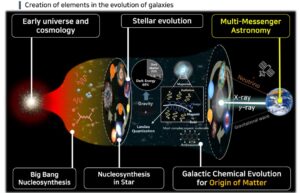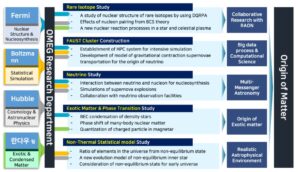Research Contents


Study Topics
(1) The Research on Nuclear structure of Rare Isotope for Astrophysical Nucleosynthesis
It is necessary to study the structure of rare nuclei, which is seen in astrophysical nucleosynthesis. In order to interpret the large amount of data derived from the heavy ion accelerator, a comprehensive nuclear structure theory must be presented. In addition, various nuclear reaction studies of related nuclei should be conducted together. In this study, it is required to interpret the study of various types of nuclear reactions generated by the rare nuclear accelerator device, which can be said to be the forefront of modern nuclear physics, and to expand it to celestial thermonuclear reactions.
(2) Supernova explosion process
A supernova explosion is the final stage of a massive star’s life. For example, in a core-collapse supernova explosion, the star consumes all its fuel and collapses due to gravity. At this time, when the core density reaches the nuclear density, the material repulses and generates a shock wave, which is called a supernova explosion. During this process, a large number of neutrinos are absorbed and released from the core, and reproducing this explosion requires hydrodynamics. These neutrinos also play an important role in stellar explosions. These neutrinos also affect thermonuclear synthesis.
(3) The Nuclear Reaction in Astrophysical Plasma
In order to make a realistic nucleosynthesis model, it is necessary to study nuclear reaction and nucleosynthesis in high-temperature and high-density plasma. For example, the Coulomb potential of a moving charged particle in an astrophysical plasma is different from that of a stationary particle. Therefore, we need to study the dynamic screening effect on nuclear reactions.
(4) Compact Objects after Supernova explosions
A neutron star is a compact object that the size of a dice with a mass of hundreds of millions of tons. Such an astrophysical object can be interpreted from the aspect of condensed-matter physics in an extreme exotic state. That is, it is necessary to study on various states, such as Bardeen-Cooper-Schrieffer (BCS) and Bose-Einstein Condensate (BEC). In addition, recent observation data by multi-messenger astronomy (MMA) such as gravitational waves and multiple data in a high-density state that can be realized through relativistic heavy ion collision experiments should be performed through computational simulations.
(5) Application of the Theory of Condensed Matter Physics
The BCS theory and density functional theory (DFT) are used to describe quantum many-body systems in condensed matter physics and nuclear physics. These theories also play an important role in the study of extreme condensed matter. In particular, the crossover phase transition from BCS to BEC with the increase of the coupling constant is used in the study of the physics of condensed matter in a high-density state. The interior of a neutron star is composed of a variety of condensed matter states, such as lattice and quark matter. In addition, the study of magnetic fields in compact objects are important for understanding high magnetic field such as magnetar and magnetohydrodynamics.
(6) Origin of Matter
All stars are born from nebulae. These stars produce heavier elements through internal nuclear reactions throughout their lifetime. In the case of the final stage of massive stars, elements are expelled into space through the supernova explosions and become nebulae again. The origin of the elements can be found from these life cycle of stars. Therefore, the goal of OMEG institute is to understand various observational data of astrophysical objects in the macroscopic world, starting from the physics in the microscopic world.